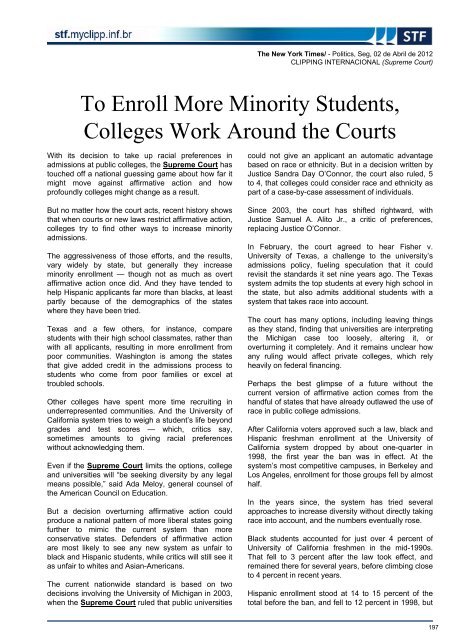STF na MÃdia - MyClipp
STF na MÃdia - MyClipp
STF na MÃdia - MyClipp
Create successful ePaper yourself
Turn your PDF publications into a flip-book with our unique Google optimized e-Paper software.
The New York Times/ - Politics, Seg, 02 de Abril de 2012<br />
CLIPPING INTERNACIONAL (Supreme Court)<br />
To Enroll More Minority Students,<br />
Colleges Work Around the Courts<br />
With its decision to take up racial preferences in<br />
admissions at public colleges, the Supreme Court has<br />
touched off a <strong>na</strong>tio<strong>na</strong>l guessing game about how far it<br />
might move against affirmative action and how<br />
profoundly colleges might change as a result.<br />
But no matter how the court acts, recent history shows<br />
that when courts or new laws restrict affirmative action,<br />
colleges try to find other ways to increase minority<br />
admissions.<br />
The aggressiveness of those efforts, and the results,<br />
vary widely by state, but generally they increase<br />
minority enrollment — though not as much as overt<br />
affirmative action once did. And they have tended to<br />
help Hispanic applicants far more than blacks, at least<br />
partly because of the demographics of the states<br />
where they have been tried.<br />
Texas and a few others, for instance, compare<br />
students with their high school classmates, rather than<br />
with all applicants, resulting in more enrollment from<br />
poor communities. Washington is among the states<br />
that give added credit in the admissions process to<br />
students who come from poor families or excel at<br />
troubled schools.<br />
Other colleges have spent more time recruiting in<br />
underrepresented communities. And the University of<br />
California system tries to weigh a student’s life beyond<br />
grades and test scores — which, critics say,<br />
sometimes amounts to giving racial preferences<br />
without acknowledging them.<br />
Even if the Supreme Court limits the options, college<br />
and universities will “be seeking diversity by any legal<br />
means possible,” said Ada Meloy, general counsel of<br />
the American Council on Education.<br />
But a decision overturning affirmative action could<br />
produce a <strong>na</strong>tio<strong>na</strong>l pattern of more liberal states going<br />
further to mimic the current system than more<br />
conservative states. Defenders of affirmative action<br />
are most likely to see any new system as unfair to<br />
black and Hispanic students, while critics will still see it<br />
as unfair to whites and Asian-Americans.<br />
The current <strong>na</strong>tionwide standard is based on two<br />
decisions involving the University of Michigan in 2003,<br />
when the Supreme Court ruled that public universities<br />
could not give an applicant an automatic advantage<br />
based on race or ethnicity. But in a decision written by<br />
Justice Sandra Day O’Connor, the court also ruled, 5<br />
to 4, that colleges could consider race and ethnicity as<br />
part of a case-by-case assessment of individuals.<br />
Since 2003, the court has shifted rightward, with<br />
Justice Samuel A. Alito Jr., a critic of preferences,<br />
replacing Justice O’Connor.<br />
In February, the court agreed to hear Fisher v.<br />
University of Texas, a challenge to the university’s<br />
admissions policy, fueling speculation that it could<br />
revisit the standards it set nine years ago. The Texas<br />
system admits the top students at every high school in<br />
the state, but also admits additio<strong>na</strong>l students with a<br />
system that takes race into account.<br />
The court has many options, including leaving things<br />
as they stand, finding that universities are interpreting<br />
the Michigan case too loosely, altering it, or<br />
overturning it completely. And it remains unclear how<br />
any ruling would affect private colleges, which rely<br />
heavily on federal fi<strong>na</strong>ncing.<br />
Perhaps the best glimpse of a future without the<br />
current version of affirmative action comes from the<br />
handful of states that have already outlawed the use of<br />
race in public college admissions.<br />
After California voters approved such a law, black and<br />
Hispanic freshman enrollment at the University of<br />
California system dropped by about one-quarter in<br />
1998, the first year the ban was in effect. At the<br />
system’s most competitive campuses, in Berkeley and<br />
Los Angeles, enrollment for those groups fell by almost<br />
half.<br />
In the years since, the system has tried several<br />
approaches to increase diversity without directly taking<br />
race into account, and the numbers eventually rose.<br />
Black students accounted for just over 4 percent of<br />
University of California freshmen in the mid-1990s.<br />
That fell to 3 percent after the law took effect, and<br />
remained there for several years, before climbing close<br />
to 4 percent in recent years.<br />
Hispanic enrollment stood at 14 to 15 percent of the<br />
total before the ban, and fell to 12 percent in 1998, but<br />
197











